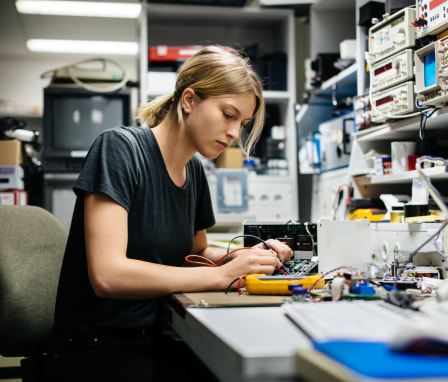 Credit: Hinterhaus Productions / Stone / Getty Images
Credit: Hinterhaus Productions / Stone / Getty Images
To be a hardware engineer by day involves working independently and with colleagues. Computer hardware engineers develop computer systems and components in labs. Hardware engineers also take part in meetings with software developers, manufacturers, and clients.
These professionals research computer components like circuit boards, processors, and memory cards to improve existing designs and innovate new ones. They also construct new computer systems and parts to match client specifications.
Keep reading to learn more about a day in the life of a computer hardware engineer.
What Is a Computer Hardware Engineer?
Computer hardware engineers help design and manufacture computer systems and components. They develop and test hardware for use in industrial, commercial, military, and scientific settings. Hardware engineers also modify existing computer hardware to maximize function and performance.
Computer hardware engineers work alongside computer scientists and collaborate on projects. The knowledge base for computer hardware engineering and computer science overlaps significantly: Hardware engineers focus on computer design and development, while computer scientists emphasize computer theory and software.
These workers usually have a bachelor's degree in computer engineering or a related field. Employers may prefer job candidates with master's degrees or ABET-accredited credentials.
What Does a Hardware Engineer Do?
Computer hardware engineers are practical, creative, and critical thinkers. They research advances in computer technology to help them create or update hardware designs. They consult with clients, software developers, and fellow engineers to develop components like processors, memory devices, routers, and networks.
Computer hardware engineers may also oversee the manufacture of hardware. They test and modify equipment to make sure it functions and meets desired outcomes. The list of key duties below provides more details about the day-to-day for hardware engineers.
Key Responsibilities of Hardware Engineers
Design Prototypes
Hardware engineers use models to design computer systems and hardware. Included in their purview are products like routers, motherboards, processing units, and related peripherals.
Draft Blueprints
As part of the hardware development process, computer hardware engineers use tools and technologies to create blueprint diagrams of their work. They also document their research and prepare specifications to stipulate details about their designs.
Test Hardware
To ensure hardware meets specifications and works appropriately, computer hardware engineers verify equipment functions correctly through usability, materials, and compliance tests. They analyze data from testing, make appropriate modifications and changes, and return to the testing process as needed.
Update Equipment
By researching innovations in information technology, computer hardware engineers can apply what they learn to existing equipment. As they update components, they also make modifications based on function assessments.
Train Users
Computer hardware engineers may need to train other designers anad clients on how to use their products. This applies to both updated and new designs.
The Day to Day of Hardware Engineering
Hardware engineers typically work full time in settings such as labs and offices. In the event that a project enters a critical phase, a problem arises, or a deadline looms, a computer hardware engineer may need to work additional hours, including nights and weekends.
These professionals may work on one or more projects each day. They often work independently to research, create schematics, and analyze testing data. These workers also document their work and provide reports to colleagues, managers, and clients.
Hardware engineers also meet with clients to dicuss hardware needs. They colloborate with software developers, other engineers, and managers through the design and manufacturing process.
Where Do Hardware Engineers Work?
The U.S. Bureau of Labor Statistics (BLS) reported that the two highest-employing industries for computer hardware engineers in 2021 were computer systems design and scientific research and development. Other high-employing industries include computer and peripheral equipment manufacturing and the federal government.
The same 2021 BLS data also shows that California, Oregon, and Colorado have the highest employment levels for computer hardware engineers. California offers the highest average wages for these professionals.
Both the highest-employing metropolitan area, San Jose-Sunnyvale-Santa Clara, and the metro area with the highest average wages — San Francisco-Oakland-Hayward — are in California. The state's strong technology sector, which includes Silicon Valley, accounts for the higher-than-average salaries and high concentration of computer hardware engineering jobs in California.
FAQ About a Computer Hardware Engineer's Typical Day
-
What is the job description of a hardware engineer?
Hardware engineers design and test computer systems and hardware components. They also upgrade existing computer equipment. These professionals collaborate with clients and other computer engineers to create hardware products.
-
How many hours does a hardware engineer work?
Computer hardware engineers typically work 40 hours per week. Some employers may require additional hours, including evenings and weekends, if problems arise or if a project is on an accelerated timeline.
-
Are computer hardware engineers happy?
Like all jobs, computer hardware engineering has its share of challenges. However, the duties for this work require creativity, problem-solving, and innovation, so people who excel in these areas may find this career rewarding.
-
Is being a hardware engineer stressful?
Being a hardware engineer can be stressful in some contexts. Prolonged issues with product development or tight deadlines can cause stress and possibly longer-than-average work weeks.
Page last reviewed on Jan 18, 2023
Recommended Reading
Take the next step toward your future.
Discover programs you’re interested in and take charge of your education.

 Reviewed by
Reviewed by